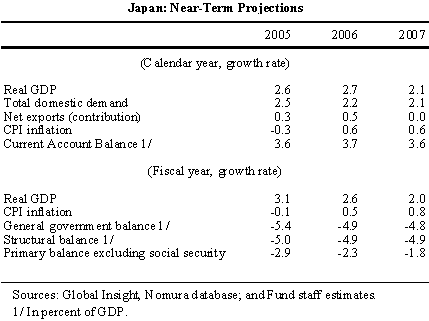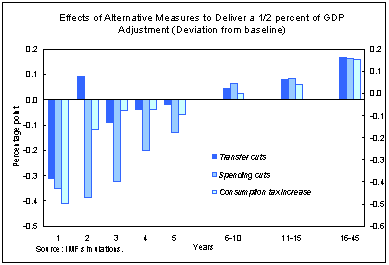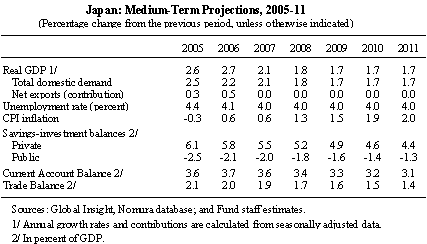Japan -- 2006 Article IV Consultation, Concluding Statement of the IMF Mission
May 24, 2006
Describes the preliminary findings of IMF staff at the conclusion of certain missions (official staff visits, in most cases to member countries). Missions are undertaken as part of regular (usually annual) consultations under Article IV of the IMF's Articles of Agreement, in the context of a request to use IMF resources (borrow from the IMF), as part of discussions of staff monitored programs, and as part of other staff reviews of economic developments.
I. Introduction
1. This statement summarizes our preliminary policy recommendations. The main issues are familiar. However, a much improved domestic economy and a renewed focus of the international community on rebalancing the pattern of global demand cast policy priorities in a new light. Both developments strengthen the case for an ambitious agenda.
II. The Outlook
2. We share the authorities' view that the near-term outlook is favorable, despite risks.
Baseline: We project GDP growth at about 2¾ percent in 2006 and about 2 percent in 2007. CPI inflation will pick up slowly as the actual output overtakes potential. The current account surplus is expected to be basically unchanged at nearly 3¾ percent of GDP in 2006-07, as strong income inflows offset a steady decline in the trade balance.
Risks: Vulnerabilities arise mainly from the unbalanced pattern of world growth (with the potential for foreign exchange pressures, financial market disruption, and a global growth slowdown) and volatile oil prices. A slowdown in growth also risks a recurrence of deflation, particularly if global imbalances unwind rapidly. On the upside, private consumption and investment could show further strength.

III. Three Macroeconomic Policy Challenges
There is basic agreement between the mission and the authorities. We share the view that maintaining an appropriate post-deflation monetary framework, undertaking a well-designed fiscal consolidation, and boosting productivity through structural reforms are complementary elements of a strategy for sustained non-inflationary growth in Japan. We also agree that these policies will not only strengthen the Japanese economy but also contribute to global financial stability as part of multilateral efforts to promote an orderly resolution of imbalances in world demand. This said, in certain areas policy implementation could be accelerated or strengthened.
A. Toward a Post-Deflation Monetary Framework
3. The orderly exit from quantitative easing since March shows skillful monetary management, and the new framework is a welcome enhancement to policy. We see the framework as broadly in line with our past recommendations and as an improvement in transparency. Our observations relate to several elements of the new framework: its implementation, the range that defines the BoJ's understanding of price stability, and the communication strategy to guide market expectations.
Policy stance: We believe the policy rate should remain at effectively zero for the near future, staying "behind the curve", which we understand is what the BoJ plans to do. There seems to be little danger of an inflation surge at present, but a reemergence of deflation could be costly. Looking further ahead, globalization and other factors are creating uncertainties about the future evolution of prices notwithstanding strong growth and a shrinking output gap. In such circumstances, we support the BoJ's intention to be attuned to a range of incoming data in the coming months and adjust its policy settings flexibly to ensure sustained noninflationary growth.
Communication issues: To give the new monetary framework maximum effectiveness, the BoJ should continue its efforts to communicate how the framework will be implemented over time. At present, this would entail continued communication of the BoJ's views on the outlook and the balance of risks, while signaling the likely near-term policy stance. Indeed, recent official speeches appear to have helped to in allay market concerns about an early tightening. More generally, we understand that the new framework will not be applied mechanically, and agree that policy flexibility is desirable. However, more explicit communication about the pros and cons of inflation in the lower end of the range may help to guide market expectations and provide the public with insights into the BoJ's policy strategy.
Understanding of price stability: The range seems to reflect differences in view among Policy Board members related to uncertainties about the extent to which structural changes and conjunctural developments may be pushing down the CPI, as well as the recent history of very low inflation. However, for the medium-term the lower bound of zero seems low. We support the BoJ Board's intention to review the range periodically and see scope for it to rise over time.
4. Monetary policy should take the lead in offsetting downside risks, if they materialize. If abrupt movements in foreign exchange markets or other external shocks were to threaten price stability, the BoJ should communicate clearly that such developments would be taken into account together with the range of other incoming data to inform the conduct of monetary policy.
B. Tackling Fiscal Imbalances
5. We continue to believe that the time is ripe for decisive fiscal consolidation. The greater-than-anticipated deficit reductions over the past two years do not seem to have held back the expansion, confirming its robust underpinnings. Our recommendations are not materially different from those made in the past. Our main observations concern the desirable pace of consolidation, the appropriate composition of expenditure and revenue measures, and their timing. (In fact, some of these issues will be clarified in forthcoming government reports).
On the pace of consolidation:
There remains a case for a more ambitious adjustment than in the authorities' medium-term plan for ½ percent per year average reduction in the primary balance of the general government excluding social security. An adjustment of ¾ percent per year, or an additional ¼ percent per year, on average, would stabilize the debt ratio sooner, buy "policy insurance" and boost the credibility of the fiscal plan.
In addition, there is a strong case for front-loading the adjustment, barring a deterioration of the conjuncture. The "good times" of above-potential growth and an accommodative monetary stance can be used to contain risk premia and prepare for population aging.1
On composition and timing: Our analytical work on alternative fiscal designs confirms the need for a package of expenditure and tax measures in a credible consolidation plan.2

Given the size of the targeted adjustment-around ¥20 trillion by FY 2011, which represents almost one quarter of FY2005 primary spending (excluding social security benefits) for the general government-and the prospective evolution of social security outlays, it seems impossible to stabilize the debt through expenditure cuts alone. In particular, an eventual increase in the consumption tax seems unavoidable, inter alia as part of a desirable shift from direct to indirect taxation as population ages, although equity considerations may also require adjustments in other tax rates. The electoral calendar might affect the finalization of the fiscal strategy but, encouragingly, background technical work is proceeding apace. The June releases of the "Roadmap for Income-Expenditure Reform" and the Basic Policies for FY 2007 will undoubtedly spur a national debate on these issues.
C. Boosting Productivity
6. Deeper and broader structural reforms would lift Japan's growth prospects and lessen the risk of a disorderly resolution of global imbalances. Much has been accomplished in the government's reform program, but the renewed attention of the international community on a concerted approach to safeguard global growth and financial stability adds some urgency to the unfinished agenda. The "agreed strategy" revolves around domestic policies that would rebalance demand across countries and limit the need for a substantial realignment of exchange rates as well as the risk of financial turbulence. A number of countries have roles to play in this process. For Japan's part, structural reforms in product and labor markets can-in time-boost domestic demand. Indeed, these reforms are consistent with both the authorities' own policy agenda and domestic interests.
7. The priorities are well known:
On labor markets, steps are needed to: boost participation by women, older workers, and marginalized youth; clarify conditions for dismissing workers; improve portability of corporate pensions (to enhance labor mobility); and balance employment conditions for regular and temporary workers.3
On product markets, productivity gains could be reaped by further deregulating sheltered sectors (e.g., retail, network services) and cutting agricultural protection.4
On promoting Japan's integration with the world economy, which by many metrics is low, steps are needed to promote further inward FDI and an ambitious conclusion of the Doha Round.
8. Although reforms would bring global benefits, continued efforts are desirable purely from domestic perspective. Quantifying the growth dividend of reforms is hard, but a variety of studies suggest that it could be substantial. The good conjuncture suggests that Japan is well placed to push ahead with reforms over the next year.
| Estimates of Gains from Structural Reform in GDP Terms | |||
|---|---|---|---|
| Bradford | Economic Planning Agency |
OECD | |
Year published |
2002 | 1994 | 2004 |
| (In percent) | |||
Static gain |
2.2 | 8.0 | 5.2 |
1-year gain (5-year horizon) |
0.4 | 1.6 | 1.0 |
Overall gain (5-year horizon) |
2.2 | 8.0 | 5.2 |
Main reform measure(s) or assumption: |
Eliminate tariffs and non-tariff barriers |
General |
Regulatory reform |
| TFP Growth Reversion (Prescott-Hayashi) | Japan Center for Economic Research | METI/Sanwa | |
|
Year published |
2002 | 2003 | 2000 |
| (In percent) | |||
|
Dynamic gain |
2.2 | 0.3 | 2.4 |
|
1-year gain (5-year horizon) |
2.2 | 0.3 | 2.4 |
|
Overall gain (5-year horizon) |
12.4 | 1.6 | 12.6 |
|
Main reform measure(s) or assumption: |
Reversion of TFP growth to 1980's rate |
Regulatory reform mainly in public services |
Deregulation and rapid diffusion of IT |
| Sources: Japan Selected Issues (2004) drawing from METI, Sanwa Research Institute (2000); Japan Center for Economic Research (2003); Shimpo and Nishizaki (1997); Bradford (2003); OECD (2004); and Hayashi and Prescott (2002). | |||
IV. Financial Sector Policy Challenges
9. With the financial system gaining further strength, financial system policy is increasingly focused on the challenges of the future. The authorities rightly recognize that changes in the financial markets call for regulatory vigilance. Investors' risk appetite is growing while abundant corporate liquidity points to robust physical and financial investment ahead. At the same time, banks and nonbank financial institutions are entering new business lines, expanding overseas and into newer markets like credit derivatives. The main issues relate to adapting supervision and regulation to an evolving financial landscape, as well as the modalities of GFI reform.
Against a background of still low core profitability in the banking system, new financial activities and rising long term rates have heightened some risks, notwithstanding healthier balance sheets. Such risks are widely viewed as manageable, however, in part because banks have worked to reduce the duration of their exposures. Looking further ahead, however, the authorities' efforts to strengthen the oversight of risk management in the context of Basel II and keep the regulatory framework abreast of the changing financial landscape are in the right direction.
Complementing these efforts, measures to promote the development of securities markets will provide over time a "spare tire" to back up the banking system. In particular, the new Financial Instruments and Exchange Law will make securities regulation more attuned to a changing environment and transparent. Along with steps to strengthen the Tokyo Stock Exchange, this will safeguard investor confidence and bolster market integrity.
The GFI reform in the works could reduce internal inefficiencies, fiscal risks, and market distortions, while providing opportunities for private banks (as shown by the effects of scaling back the government housing loan corporation ). In implementation, the reforms should ensure profitability and stability of the new consolidated entity, and should not entail undue financial support or regulatory forbearance.
V. The Medium-Term Outlook
10. In our baseline scenario, we foresee that over the medium term GDP growth would revert to potential and the current account would narrow moderately. Under the World Economic Outlook assumptions of current policies and a constant real effective exchange rate, declining household saving and rising private investment provide an offset to fiscal consolidation and the saving-investment gap falls gradually.

11. Ambitious structural reforms would help boost growth further and promote additional external adjustment. Illustrative simulations from the IMF's Global Economic Model suggest that reforms that lift productivity growth in Japan by ½ percent per year-a figure within the range of estimated gains from product and labor market reforms-would reduce the current account over the medium term by some 1/3 percent of GDP, notwithstanding a sustained fiscal adjustment.5 In this scenario there would be a small appreciation of the yen in effective terms. These results do not assume implementation of the "agreed strategy" outside Japan-notably, fiscal consolidation in the United States, greater exchange rate flexibility in emerging Asia, and pro-growth reforms in Europe. As part of a concerted policy effort, a vigorous reform program in Japan would help reduce the risk of a disorderly adjustment of global imbalances that could entail world slower growth and sharp exchange rate movements.
***
We thank the authorities for their close cooperation and warm hospitality. We have benefited a great deal from our discussions over the past week and look forward to your views on these preliminary conclusions.
1 Given a weak relationship between output and prices, a more ambitious fiscal plan is unlikely to rekindle deflation pressures (we estimate the impact fiscal multipliers at 0.6-0.8).
2 This analytical work will be presented at the IMF seminar on Tuesday, May 23.
3 Current regulations favor the employment of non-regular workers, for example by excluding them from social insurance coverage. Limited job tenure reduces firms' incentives to train their workforce, depressing aggregate productivity.
4 The government's New Economic Growth Strategy could usefully focus on deregulation rather than industrial policy approaches.
5 These simulations are reported in the background paper for last year's Article IV consultation (IMF Country Report No. 05/272 at www.imf.org).
IMF EXTERNAL RELATIONS DEPARTMENT
| Public Affairs | Media Relations | |||
|---|---|---|---|---|
| E-mail: | publicaffairs@imf.org | E-mail: | media@imf.org | |
| Fax: | 202-623-6220 | Phone: | 202-623-7100 | |


